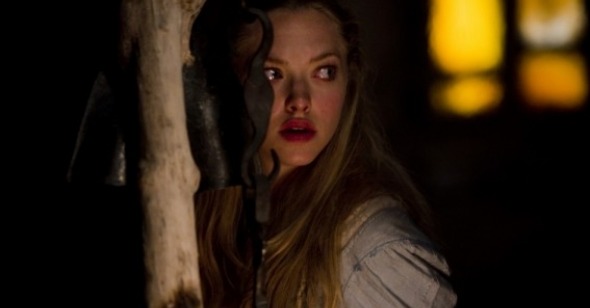Monday Hangover:
Red Riding Hood
by Adam Nayman and Michael Koresky
It would be accurate enough to say that Red Riding Hood suggests a book report on Bruno Bettelheim’s landmark psychoanalytic study of fairy tales The Uses of Enchantment by a student who was pressed for time and just skimmed the Wikipedia page. But in order to really convey the hallucinatory awfulness of this movie, you’d have to flesh out this hypothetical scenario a little further and say that the student suffered a severe head trauma on her way to reading the paper out loud to the class. With its unmotivated camera movements, erratic cutting, and supremely wobbly orchestration of parallel events, Catherine Hardwicke’s direction is the cinematic equivalent of a concussion.
Certainly somebody seems to have clonked Amanda Seyfried on the head prior to about half her scenes in Red Riding Hood. Faintly dazed at the best of times (like in Mean Girls), the actress looks even droopier than usual as Valerie, the proverbial babe in the woods whose beauty and virginity are irresistible lures for the lupine. When the Big Bad CGI Wolf lopes up to her and asks her to come away with him—I add that he does this telepathically—the actress’s stunned expression is like a mirror for the viewer: she can’t believe this is happening, either.
It’s entirely possible that David Leslie Johnson’s screenplay, which complicates Charles Perrault’s fable of sexual predation with love triangles, buried family secrets, and Gary Oldman as a Fearless Werewolf Killer with silver-dusted fingernails and a fondness for sticking dissenters into a cast-iron elephant and toasting them over coals, is intentionally campy along the lines of his script for Orphan. The difference is that Hardwicke’s addled filmmaking clouds the issue, where Jaume Collet-Serra’s crystalline direction clarified it. The narrative incoherence pales next to—and is exacerbated by—the visual incoherence, and the decisions that appear to have been made purposefully are even worse. A scene in which Valerie’s slightly zaftig friend offers her body to Oldman’s Father Solomon in exchange for her sparing her mentally retarded younger brother’s from more time stewing inside the pachydermic slow-cooker contains a built-in pause so that the audience can echo the actor’s dismissive laugh—lovely stuff from a director who has always paid lip service to feminist themes. —AN
Come on, Adam. Red Riding Hood has it all: mystery (who’s the wolf?), suspense (when will the wolf kill next?), horror (wow, that wolf done killed a lot of people!), romance (I hope Amanda Seyfried gets it on with that wolf…woof!), and comedy (wow, that wolf looks less convincing than the one from early CGI howler An American Werewolf in Paris). But wait: Catherine Hardwicke’s PG-13–rated latest, seemingly calculated both for tween girl sleepovers and the bloodthirsty older brothers who might be grazing in the background, also has intimations of incest (wait, the werewolf isn’t either of the teen hotties Valerie must choose between—it’s . . . wait, really?), scenes of torture (a gruesome homage to Moulin Rouge, the patron saint of pomo garbage of the aughts), fairly forthright S&M imagery (don’t Google “steel wolf or puppy masks,” one of which Seyfried is forced to wear while manacled to a rock in the town square), and . . . Julie Christie.
Despite all this, like, totally weird adultness, Red Riding Hood still manages to feel about as frighteningly sharp as the nibbles of a naughty newborn kitty. Completely indifferent to the actual fairy tale on which it’s supposedly based (save for the “all the better to hear/see/eat you with” exchange, here chintzily relegated to a dream sequence), Hardwicke’s film is instead an attempt at courting the director’s fan base, which encompasses viewers of both Twilight and the even worse Thirteen. At least RRH forgoes that latter film’s “lock up your daughters” alarmism, replacing it with a more palpable hormonal hysteria—the two lusty lads completing Seyfried’s love triangle may not give Robert Pattinson a run for his money in the dreamboy department, but shifty-eyed Shiloh Fernandez and earnest son-of-Jeremy Max Irons are each wolfish enough to at least gain high mention in The Dangerous Book for Boys. And Seyfried, for her part, with her Michelle Pfeiffer-meets-E.T. looks, manages conveys shades of desire beneath her cloaked veil of safe purity—or maybe I was just recalling her sex scenes with Julianne Moore from Chloe.
But do we—that is, grown, male critics—really need Hardwicke’s movie to be anything more than a bodice ripper for the braces and acne crowd? (We already have Neil Jordan’s excellent, truly unsettling The Company of Wolves for our own interests in the Little Red Riding Hood bedtime story.) The film barely even aspires to Robin McKinney’s levels of fairy-tale feminism, let alone Catherine Breillat’s, with her recent deconstructions in Bluebeard and The Sleeping Beauty. Despite its narrative madcappery and (how can I say this politely?) visual inelegance, this stuff is fairy straightforward little-girl wish fulfillment: the girl gets the wolf and grandma’s delicious cookies. And there’s at least one sly nod to the film’s target audience: a scene featuring the two boys fighting over our heroine is punctuated with a cut to two tween girls, minor characters both, exchanging a satisfied giggle. —MK
